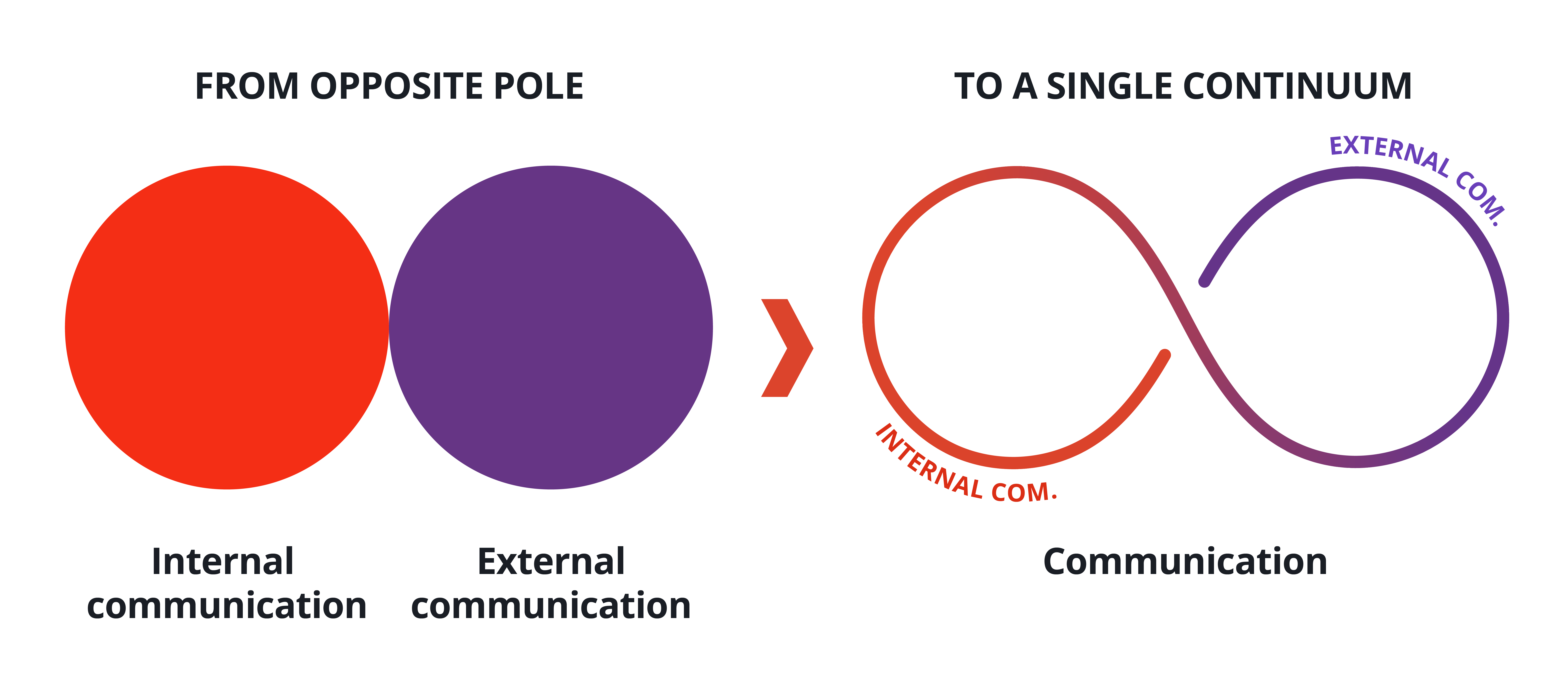Between internal and external communication
An integrated approach for coherent and sustainable communication
Introduction
Companies are increasingly multifaceted realities and, hopefully, increasingly aware of how their reputation is omnidriven, that is, influenced by a variety of factors that equally intersect internal communication activities with those aimed at external audiences.
Building on this assumption, today’s communicators had better be able to integrate this mutual influence into their communication strategies, since the company must be recognizable in each of its manifestations, with a single voice. To build this identity coherence and prevent reputational gaps, it is important to know what unites and what differentiates internal and external communication dynamics with the goal of aligning them in an integrated approach.
Opposing poles or part of a whole?
Internal vs. external communication: we almost always find these two forms pitted against each other as if they were two antagonistic poles, which makes it challenging to put into practice the integrated approach that organizations should strive for.
Therefore, in the following lines, we have tried to imagine external and internal communication by adopting a less divisive lens and asked ourselves: what would change if we considered them as two partners living a long-term relationship? By virtue of the strength by which they are bound, they collaborate on mutual goals albeit demonstrating some natural differences: they may have different opinions, various modes of expression or even different solutions to achieve the same goal. And the same happens with internal and external communication. Let’s see together how.
Toward an increasingly integrated approach

Adopting this more holistic view allows us to consider internal and external communication as increasingly integrated, without distorting the distinctiveness of each. Indeed, we should not be surprised by the natural existence of some differentiating elements such as:
audience: while internal communication directly addresses those who work in the company, external communication involves - in addition to employees as ambassadors - external stakeholders such as current or potential customers, shareholders, investors, media, suppliers, regulators or other government agencies;
purpose: internal communication enhances the employee experience, strengthens the sense of belonging, and increasingly contributes to the achievement of certain strategic goals related to the company's purpose, that is, the reason why a company was started. On the other hand, external communication nurtures a broader ambition to attract different audiences, to make itself known, to catalyze attention to the value it builds by its existence;
communication channels: internal communication works to establish and publicize the company's goals, engage employees, and make sure to provide timely and timely information; to do this it prefers more direct channels such as email and DEM, intranet, company social networks, house organ, company spaces. External communication, on the other hand, disseminates information to the public through a more varied range of media: the owned ones (website, store, app, brochures, social networks), the paid ones, through which the distribution of a content takes place behind investment (newspapers, TV, billboards, adv campaigns on social), the shared ones where one's audience amplifies the reach of the content produced, and, finally, the earned ones, i.e., those free channels where visibility is gained through public relations.
There is one last element that, although considered as differentiating the literature, is in our opinion a factor that serves as a “springboard”: we are talking about the timing of communication, both internal and external. Constancy and frequency of publication, without excess, play a key role in both cases to avoid information overload, but it is above all the synergy of the two times that determines the uniformity of both forms of communication.
In fact, it is considered synonymous with lack of attention and sensitivity when employees learn about important business decisions or an advertising campaign first from external media, and, only second, from the internal tools available to them. An anachronistic move that creates a disconnect between employee and company and weakens that bond so valuable in building the company’s reputation. It becomes essential to ground a fence of consistency between internal and external where communication has the task of acting as the glue between employees, customers and the company. And here we deliberately speak of communication in the round, without any label.
A company’s success requires that internal and external communicators increasingly work in synergy, making themselves complementary, in order to ensure uniformity in the development of the messages transferred. Reinforcing this need is the very nature of organizations, which no longer have exclusive control over communication: with the increasingly cross-cutting use of social networks, every person, whether a customer or an employee, becomes a potential communicator. From this we deduce that thinking that one can build a good reputation with external communication alone is a chimera, an illusion with no connection to reality.
Conclusions
Convergence and constant alignment are the key words for us to ensure that internal and external communication-from their respective points of view-progress in alignment by working in synergy without ever losing sight of the common goals. Their declination will certainly differ, but the point of arrival is desirable to always coincide. Companies today are dealing with a transition that, even before being strategic, is a cultural shift to be managed with a renewed sensitivity to the beating heart of organizations: their people.
If you want to learn more, don’t miss the upcoming articles that will delve into the Communication Alignment Map (CAM) model, a useful tool for creating a perfect synergy between internal and external communication.
Bibliography and sitography
- Fink L, (2022), Letter to CEOs – The Power of Capitalism
- Watlers, K (2019), The Bridge Between Internal and External Communication
Author
Ivana Radenovska

 9 June 2022
9 June 2022
